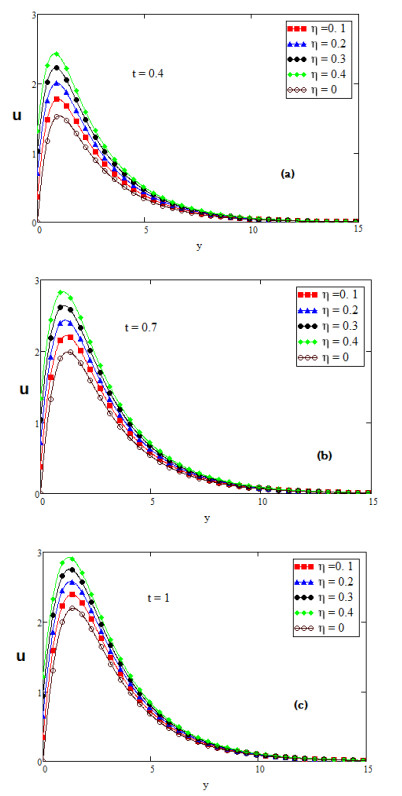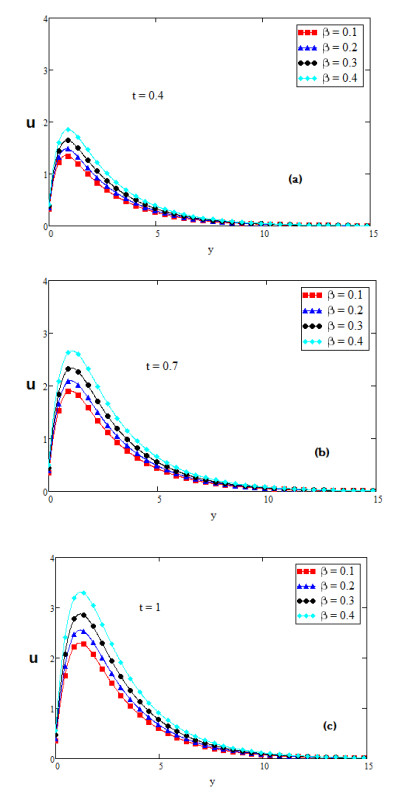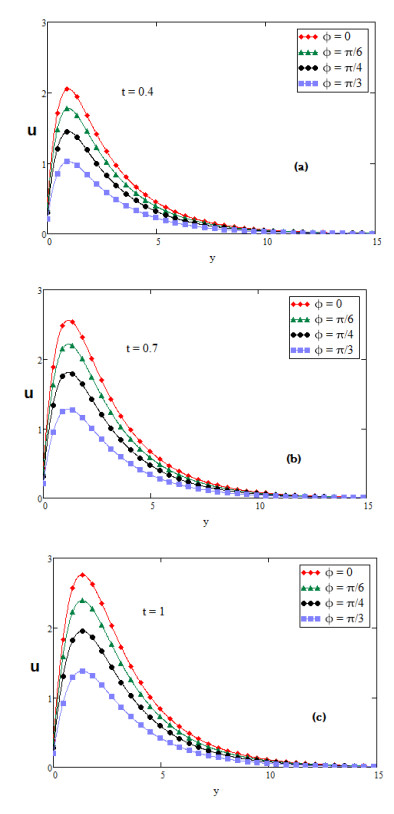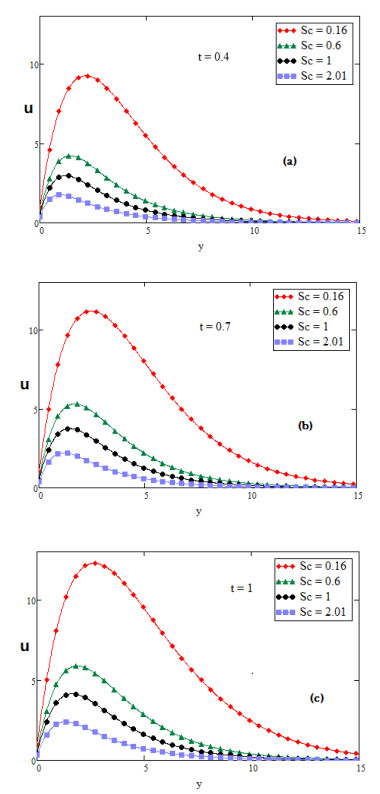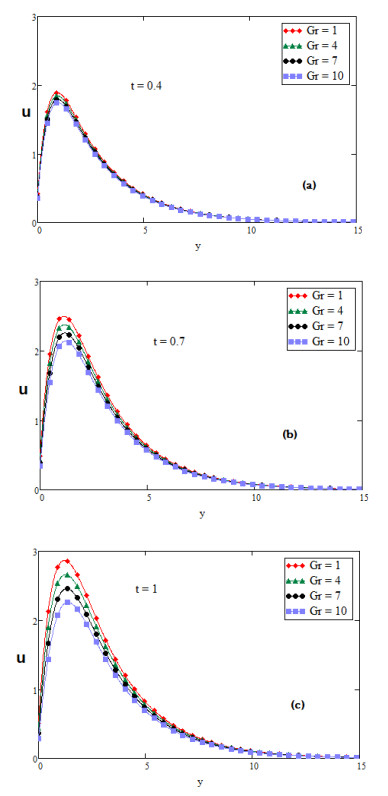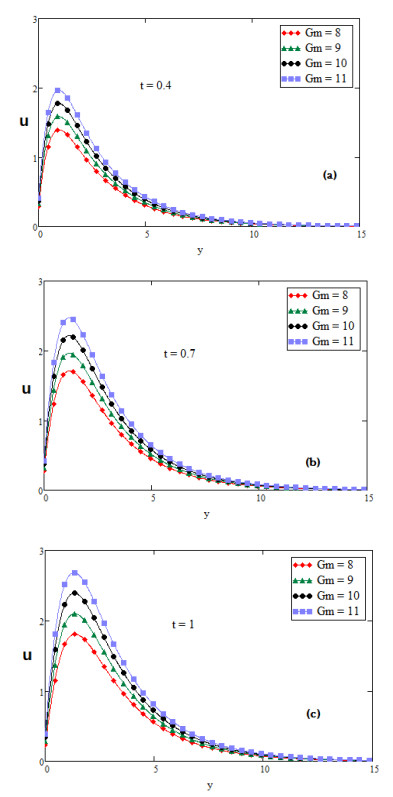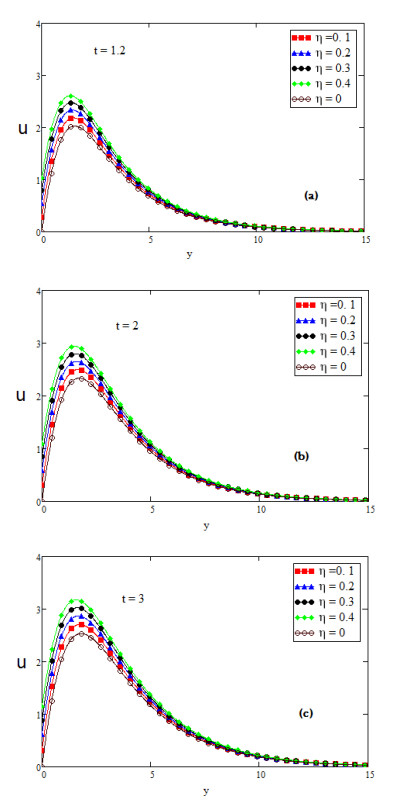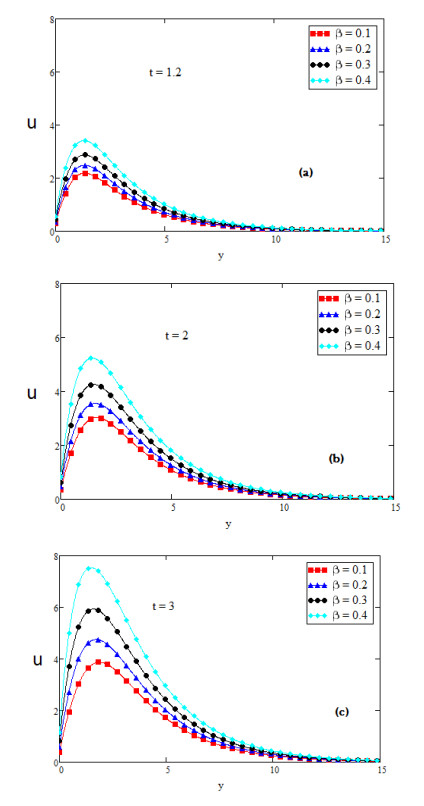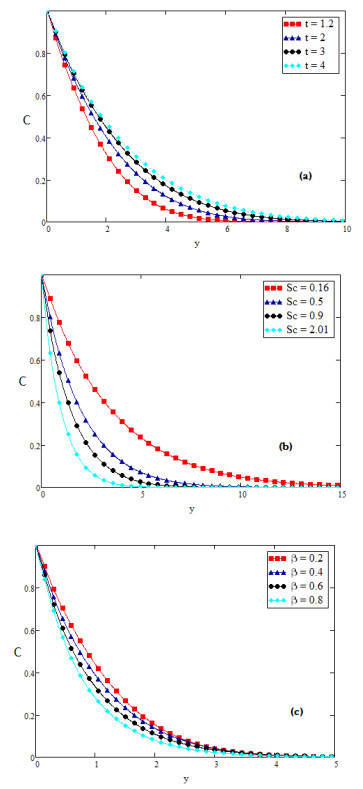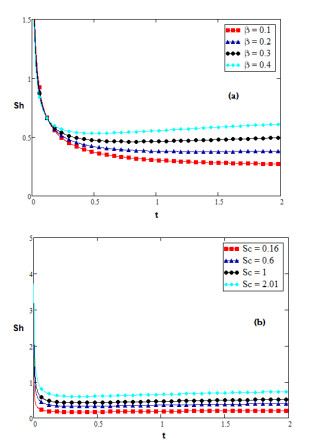Unsteady free convection slip flow of second grade fluid over an infinite heated inclined plate is discussed. The effects of mass diffusions in the flow are also eligible. Caputo-Fabrizio fractional derivative is used in the constitutive equations of heat and mass transfer respectively. Laplace transform is utilized to operate the set of fractional governing equations for both ramped and stepped wall temperature. Expression for Sherwood number and Nusselt number with non-integer order are found by differentiating the analytical solutions of fluid concentration and temperature. Numerical results of Sherwood number, Nusselt number and skin friction are demonstrated in tables. Solutions are plotted graphically to analyze the impact of distinct parameters i.e. Caputo-Fabrizio fractional parameter, second grade parameter, slip parameter, Prandtl number, Schmidt number, thermal Grashof number and mass Grashof number to observe the physical behavior of the flow.
1.
Introduction
Non-Newtonian fluids consist of three main groups which depend on their performance in the shear. The second grade fluid is one of the popular in the common models of non-Newtonian fluids. Firstly Coleman and Noll [1] configured the mathematical model of second grade fluid. Later this scheme was carrying out to interpret various problems that have approximately simple construction. To explain the pattern of non- Newtonian fluids, the second order Rivlin-Ericksen equation has been applied by Erdogan and Imrak [2]. In this research article they discussed about unsteady Poiseuille flux, unsteady flow across a float sheet and the coquette flow.
Nevertheless, all the researchers are more on vertical plates. Many researchers worked on the flow nearby inclined plates or surfaces, though in real application, such as crystal growth and solar energy collection. Chamkha [3] has discussed the Hydromagnetic free convection flow through an isothermal inclined plate under the impact of the thermal porous sheet. The heat transfer of an inner rotational flow over an inclined sheet has been explored by kimura et al. [4]. The analytical solution of free convection flow, which is unsteady in nature flowing over an inclined rotating plate was scrutinized by Toki [5].
The field of fractional calculus (FC) is that branch of applied analysis that is, in a certain sense, as old as classical calculus as it well known at present time. Leibniz and Newton formed the bases of integral and differential calculus in the seventeenth century. In 1695, when Leibniz notice the symbol which is employed for the nth derivative of a function f in a letter to de l'Hospital. De l'Hospital arise a question that what does the nth derivative of a function f mean if n=12. Now a days this important letter from de L'Hospital as commonly accepted as the first instant which is known as fractional derivative [6]. In particular, fractional derivative of certain substantial problems are more appropriate than regular derivative. This is because of two key reasons firstly, we have the freedom to select any order for the differential and integral operators, and not be restricted to integer-order only. Secondly, fractional derivatives depend not only at the present time but also at the past, so they are very suitable and accurate when the system has a long-term memory. It has several applications not only in engineering and physical sciences but also in other areas such as geology, ecology, biology and chemistry etc [7]. In fluid dynamics fractional calculus has been expanded in the opposite direction. To interpret the viscoelastic nature of materials, fractional calculus has been used. Friedrich [8] successfully applied the fractional approach to explain the viscoelastic of material. The utilization of fractional derivative in viscoelasticity has been proposed by Gemant [9]. It has several uses in natural science and engineering like as geology, physics, ecology, biology and chemistry, etc. This tool efficiency to generalize some physical concept was used by Palade et al. [10]. Transport phenomena exhibit is sub diffusion for and super diffusion for β∈(0,1) and super diffusion for β>1, where β is the fractional parameter.
Among the recently published article, the fractional derivative of free convection flow on a vertical sheet with mass diffusion and heating of Newtonian fluid was explored by Vieru et al. [11]. Zafar and Fetecau [12] studied the motion of a viscous fluid involving fractional operator without singular kernel on infinite sheet. The free convection flow of a fractional viscous fluid over the vertical sheet by applying shear stress to the fluid has been explored by Nehad et al. [13]. Imran et al. [14] reported the second grade fluid with Caputo fractional approach. An extended second grade fluid model with double convection flow with MHD on an exponentially increasing infinite perpendicular plate has been investigated by Nazar et al. [15]. Imran et al. [7] have analyzed comparatively the flow of second grade fluid with fractional approaches (Caputo and Caputo-Fabrizio (CF)) and Newtonian heating. The free convection second grade fluid flow with ramped wall temperature has been explored by Samiulhaq et al. [16]. The second grade fluid with MHD among two parallel walls normal to the plate under the effects of porous medium has been scrutinized by Samiulhaq et al. [17]. The MHD flow of Williamson nanofluid with the impacts of distinct parameters is studied by Gupta et al. [18]. MHD 3-D boundary layer flow and heat transfer of nanofluid induced by convective conditions is examined by Gupta et al. [19]. In an another article Gupta et al. [20] reported a study on MHD mixed convective stagnation point flow and heat transfer of an incompressible fluid containing nanoparticles through an inclined stretching surface having different kind of effects. In the last few years, many authors used the fractional operators in scientific applications [21,22,23,24,25,26,27,28,29,30,31,32,33,34,35].
The purpose of the present note is to study the unsteady natural convection second grade fluid over an infinite heated inclined plate with the impact of slip condition. CF operator is used in the constitutive equations of heat and mass transfer respectively. Integral transform method (Laplace transformation) is utilized to operate the set of fractional governing equations for both ramped and stepped wall temperature. The effects of memory parameters, i.e. CF fractional parameter β are graphically studied. Following are main contribution in this article.
1. The impact of slip boundary condition over an infinite heated inclined plate.
2. CF fractional derivative of second grade fluid with the impact of wall slip condition.
3. Laplace transform method is employed the set of fractional governing equations for constant as well as ramped wall temperature.
2.
Analysis of the governing problem
Here we assume the unsteady free convection slip flow of second grade fluid over an infinite heated inclined plate. Taking x−axis in upward direction along the plate while y−axis is perpendicular to it. Initially for t′≤0, both the fluid and the plate are at rest position at the constant temperature T′∞ and concentration C′∞. When 0<t′≤t0 the plate temperature is elevated or declined to {T′∞+(T′w−T′∞)t′t0 and for t′>t0 the plate temperature is kept at uniform temperature Tw and the level of concentration at the plate is elevated to C′w or concentrations is accrued to the plate at fixed rate. It is assumed that temperature, concentration and velocity are dependent over t and y only. By Boussinesq's approximation, the governing equations of the problem are [36,37].
The corresponding initial conditions (ICs) and boundary conditions (BCs)are under as:
In the above equation λ is the slip parameter.
In order to reduce the number of variables involved in the governing equation, we introduce dimensionless variables as follows
Using these non-dimensional variables (2.5) in Eq. (2.1), and removing the star notation the Eq. (2.1) take the simplest form as
The equation of the thermal balance in local form explained the diffusion phenomenon of heat as
Where ρ represent the fixed fluid density, cp represent the specific heat, ∇ represent the gradient operator and q(y,t) represent the thermal flux density.
Henry et al. [38] and Hristov [39,40] suggested the fractional generalization Fourier law which is consider for the thermal heat flux as
In the above equation Dβt is the CF operator and their definition can be seen in appendix.
Using Eq. (2.8) in Eq. (2.7) we get,
Using the dimensionless parameters (2.5) in Eq. (2.9) and dropping out the star notation, Eq. (2.9) take the simplest form as
Consider the Fick's law,
Where j represent the flux of particles and ∇ represent the gradient operator.
To eliminate flux from Fick's law, we can use the conservation equation
Making use of Eq. (2.12) in Eq. (2.11), we get
Using the dimensionless variables (2.5) in Eq. (2.13) and dropping out the star notation, Eq. (2.13) take the simplest form as
where Eq. (2.6) is in classical form, and Eqs. (2.10) and (2.14) are in CF time fractional operator model of order β∈(0,1).
In the above expressions u, y, t, C, θ, Gr, Gm, Sc and Pr denote the velocity, coordinate axis, time, concentration, temperature, thermal Grashof number, mass Grashof number, Schmidt number and Prandtl number respectively. Moreover, characteristics time t0 can be define as
The associated initial and boundary condition (2.4) are given below:
In the above equation η indicates the slip parameter.
3.
Analytical solutions
We know propose to solve equations (2.6), (2.10) and (2.14) having the ICs and BCs (2.16) with the aid of Laplace transform (LT) algorithm. Since the velocity equation depends upon the temperature and concentration, so we first find the solutions for temperature and concentration.
3.1. Solution for ramped temperature
Using the LT technique to Eq. (2.10) and the utilizing the initial and boundary condition (2.16), we have
The solution of Eq. (3.1) with BCs (3.2) is
The inverse LT of Eq. (3.3) is
In the above expression,
And the unit step function H(t−1) is presented as
Where r is any constant.
3.2. Solution for concentration profile
Applying LT technique to Eq. (2.14) and utilizing the ICs and BCs (2.16), we have
The solution of Eq. (3.6) with boundary condition (3.7) is
Using the inverse LT, the solution for concentration is obtained as
3.3. Solution for ramped velocity
Applying LT technique to Eq. (2.6), and utilizing ICs and BCs (2.16), we obtain
The solution of (3.10) with BCs (3.11) is
where
Equation (3.12) can be written in inverse LT as
where
3.4. Solution for constant Temperature
Now using LT technique to Eq. (2.10) and employing ICs and BCs (2.16), we get
The solution of (3.14) with boundary condition (3.15) is
Now using the inverse LT to Eq. (3.16), we have
3.5. Solution for constant Velocity
Applying LT technique to Eq. (2.6), and employing ICs and BCs (2.16), we obtain
The solution of (3.18) with BCs (3.11) is
where
Equation (3.19) can be written in inverse LT as
3.6. Nusselt number
The rate of heat transfer can be computed in terms of Nusselt number as
3.7. Sherwood number
The rate of mass transfer can be computed in terms of Sherwood number as
4.
Result and discussion
The unsteady free convection slip flow of an incompressible second grade fluid over an infinite heated inclined plate with fractional parameter β is studied. The solutions of dimensionless velocity, concentration and temperature are evaluated with the aid of Laplace transform technique. Expression for Sherwood number and Nusselt number with fractional parameter β are obtained by differentiating the solutions of fluid concentration and temperature.
For the physical illustration of the studied problem, the values of temperature, velocity and concentration profiles are calculated, and displayed graphically for several values of distinct parameters such as Prandtl number Pr, second grade parameter α, inclination parameter ϕ, fractional parameter β, Schmidt number Sc, thermal Grashof number Gr, mass Grashof number Gm and slip parameter η. In Figures (2-14); graphs (a), (b) and (c) discuss the nature of temperature, concentration, velocity, nusselt number and Sherwood number for diverse values of time t. The effect of slip parameter is shown in Figure 2. The fluid velocity is accelerated if the value of slip parameter η is increased. The speed of fluid is high near the plate and the boundary layer thickness rises for large value of t. It is also depicted in Figure 2 that the fluid velocity with slip at the wall is higher than the fluid velocity with no slip at the wall. Figure 3 is plotted to perceive the effect of fractional parameter β. It has been seen that the motion of Fluid rises and displays maximum value near the plate for large values of fractional parameter β. It is obvious from Figure 4 that growing values of inclination parameter ϕ decelerates the motion of fluid. It is observed from Figure 5 that the fluid velocity rises for large value of Prandtl number (Pr). Figure 6 shows that viscous forces overcome the diffusional effects for large value of Schmidt number Sc. Mass transfer by diffusion and the relative effectiveness momentum in the concentration and velocity in free convection flow regimes are represented by Schmidt number. If we increase the value of Sc then momentum diffusion will counteract, molecular diffusivity will be reduced and viscosity effects will accelerated. Therefore the flow will be decreased for large value of Sc as shown in Figure 6. Ramping of the enclosing channel walls can help to decelerate velocities, which is an important feature, for example in achieving better flow control in nuclear engineering applications. The effect of thermal Grashof number Gr is shown in Figure 7. It is perceived that the fluid velocity is falling, if we increase the value of thermal Grashof number Gm. The thermal Grashof number is the ratio of thermal buoyancy force to viscous force, which causes free convection. Figure 8 shows the influence of mass Grashof number Gm. The mass Grashof number is the ratio of mass buoyancy force to viscous force, which causes free convection. It is perceived that the fluid velocity is increasing, if we increase the value of mass Grashof number Gm. In Figure 2 to Figure 8 we discussed the behavior of velocity with different values of physical parameters for ramped wall temperature. It is clearly seen from Figures 9 and 10 that growing values of fractional parameter β and slip parameter η, increases the motion of fluid in case of constant wall temperature. Furthermore, it has been analyzed that the motion of fluid is increasing by increasing time t.
Figure 11 demonstrates the variants in temperature portrayal for numerous values of Pr and fractional parameter β. It has been perceived that growing values of Pr decay the variations of temperature while increases for large value of fractional parameter β. Physically, it is true due to the fact that if we increase the Pr then viscosity of the fluid is increasing and thermal conductivity is decreasing and hence decreases the thickness of thermal boundary-layer. It is evident from Figure 11 that temperature is accelerated for growing value of time t. In Figure 12 we discussed the nature of concentration for distinct values of fractional parameter β, time t and Schmidt number Sc. It is clear from Figure 12 that for large value of Schmidt number Sc and fractional parameter β, concentration is decreasing while increasing for greater value of time t.
Figure 13 displays the modification of Nusselt number for diverse values of β and Pr. It also perceived that Nusselt number accelerates for higher value of Pr and decelerates for higher value of fractional parameter β.
Figure 14 displays the modification of Sherwood number for distinct values of β and Pr. It is clearly noted from Figure 14 that Sherwood number is enhancing for large value of Pr and fractional parameter β.
5.
Numerical tables
Numerical results of the rate of shear stress (skin friction τ), heat transfer (Nusselt number Nu) and mass transfer (Sherwood number Sh) at the plate are expressed in Tables 1 to 3 for different values of (η), (Pr), (Sc), (Gm), (Gr), (α), (β), (ϕ) and (t) in case of ramped wall temperature. It is noted from Table 2 that growing values of (Gm), (Gr), (β) and (t) accelerates the skin friction (τ), while decelerates for growing values of (η), (Pr), (α), (ϕ) and (Sc). It is detected from Table 2 that growing values of (Pr) and (t) accelerates the Nusselt number (Nu), while decelerates for growing values of (β). It is noticeable from Table 3 that Sherwood number (Sh) enhances for growing value of (Sc) and (β), while decreases for large value of (t).
6.
Conclusions
The second grade fluid which is unsteady and incompressible in nature flowing over an infinite heated inclined plate under the influence of slip condition are studied. CF derivative is used in the constitutive equations of heat and mass transfer respectively. An analytical solution is obtained by integral transform method (Laplace transformation) for velocity, concentration and temperature fields for both stepped and ramped wall temperature. Expression for Sherwood and Nusselt numbers with fractional parameter are obtained by differentiating the analytical solutions of fluid temperature and concentration. The effect of different parameters i.e. Caputo-Fabrizio fractional parameter β, second grade parameter α, slip parameter η, Prandtl number Pr, Schmidt number Sc, thermal Grashof number Gr and mass Grashof number Gm are graphically studied. Following are the some observations and concluding remarks :
1. The motion of fluid accelerates for growing value of slip parameter η in case of ramped as well as stepped wall temperature.
2. The motion of fluid is increasing and displays maximum value near the plate for large values of fractional parameter β in case of ramped as well as stepped wall temperature.
3. Growing values of inclination parameter ϕ and thermal Grashof number Gr decelerates the motion of fluid.
4. viscous forces overcome the diffusional effects for large value of Schmidt number Sc. Mass transfer by diffusion and the relative effectiveness momentum in the concentration and velocity in free convection flow regimes are represented by Schmidt number. Effectively, therefore momentum diffusion will counteract for large value of Sc, since molecular diffusivity will be decelerated and viscosity effects will accelerated. Therefore the flow will be decreased for large value of Sc. Ramping of the enclosing channel walls can help to decelerate velocities, which is an important feature, for example in achieving better flow control in nuclear engineering processes.
5. The fluid velocity is accelerated for large value of Prandtl number Pr and Grashof number of mass Gm.
6. Growing values of Prandtl number Pr decay the variations of temperature and Nusselt number.
7. Temperature, Concentration and Nusselt number are decreasing for large value of fractional parameter β.
Conflict of interest
The authors declare no conflict of interest.
Appendix
1. The Caputo-Fabrizio (CF) fractional operator [41,42] can be written as
The laplace transform of DβtT(y,t) can be given as
2. The Caputo fractional derivative [41] can be written as
Where β∈[0,1] and a∈[−∞,t], f∈H1(a,b),b>a
The new definition of Caputo fractional time derivative [41] is
In the above equation M(β) is a normalization function such that M(0)=M(1)=1.
3. The Riemann-Liuville fractional derivative [43] can be written as:
If n is a positive integer and β∈[n−1,n), the β derivative of a function f is given by
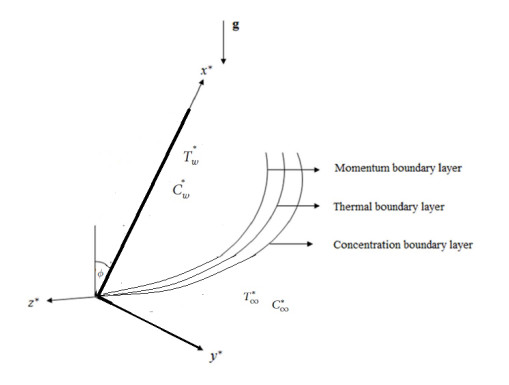









 DownLoad:
DownLoad:
